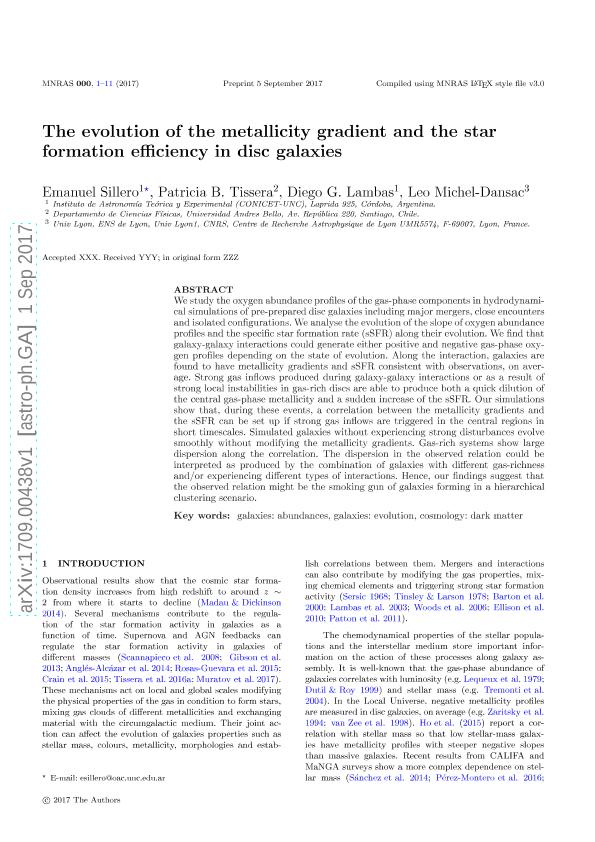Mostrar el registro sencillo del ítem
dc.contributor.author
Sillero Ros, Guillermo Emanuel

dc.contributor.author
Tissera, Patricia Beatriz

dc.contributor.author
Garcia Lambas, Diego Rodolfo

dc.contributor.author
Michel-Dansac, Leopold Laurent Joseph

dc.date.available
2018-11-21T18:00:26Z
dc.date.issued
2017-12
dc.identifier.citation
Sillero Ros, Guillermo Emanuel; Tissera, Patricia Beatriz; Garcia Lambas, Diego Rodolfo; Michel-Dansac, Leopold Laurent Joseph; The evolution of the metallicity gradient and the star formation efficiency in disc galaxies; Wiley Blackwell Publishing, Inc; Monthly Notices of the Royal Astronomical Society; 472; 4; 12-2017; 4404-4413
dc.identifier.issn
0035-8711
dc.identifier.uri
http://hdl.handle.net/11336/64869
dc.description.abstract
We study the oxygen abundance profiles of the gas-phase components in hydrodynamical simulations of pre-prepared disc galaxies including major mergers, close encounters and isolated configurations. We analyse the evolution of the slope of oxygen abundance profiles and the specific star formation rate (sSFR) along their evolution. We find that galaxy-galaxy interactions could generate either positive or negative gas-phase oxygen profiles, depending on the state of evolution. Along the interaction, galaxies are found to have metallicity gradients and sSFR consistent with observations, on average. Strong gas inflows produced during galaxy- galaxy interactions or as a result of strong local instabilities in gas-rich discs are able to produce both a quick dilution of the central gas-phase metallicity and a sudden increase of the sSFR. Our simulations show that, during these events, a correlation between the metallicity gradients and the sSFR can be set up if strong gas inflows are triggered in the central regions in short time-scales. Simulated galaxies without experiencing strong disturbances evolve smoothly without modifying the metallicity gradients. Gas-rich systems show large dispersion along the correlation. The dispersion in the observed relation could be interpreted as produced by the combination of galaxies with different gas-richness and/or experiencing different types of interactions. Hence, our findings suggest that the observed relation might be the smoking gun of galaxies forming in a hierarchical clustering scenario.
dc.format
application/pdf
dc.language.iso
eng
dc.publisher
Wiley Blackwell Publishing, Inc

dc.rights
info:eu-repo/semantics/openAccess
dc.rights.uri
https://creativecommons.org/licenses/by-nc-sa/2.5/ar/
dc.subject
Dark Matter
dc.subject
Galaxies: Abundances
dc.subject
Galaxies: Evolution
dc.subject.classification
Astronomía

dc.subject.classification
Ciencias Físicas

dc.subject.classification
CIENCIAS NATURALES Y EXACTAS

dc.title
The evolution of the metallicity gradient and the star formation efficiency in disc galaxies
dc.type
info:eu-repo/semantics/article
dc.type
info:ar-repo/semantics/artículo
dc.type
info:eu-repo/semantics/publishedVersion
dc.date.updated
2018-10-19T15:37:09Z
dc.journal.volume
472
dc.journal.number
4
dc.journal.pagination
4404-4413
dc.journal.pais
Reino Unido

dc.journal.ciudad
Londres
dc.description.fil
Fil: Sillero Ros, Guillermo Emanuel. Consejo Nacional de Investigaciones Científicas y Técnicas. Centro Científico Tecnológico Conicet - Córdoba. Instituto de Astronomía Teórica y Experimental. Universidad Nacional de Córdoba. Observatorio Astronómico de Córdoba. Instituto de Astronomía Teórica y Experimental; Argentina
dc.description.fil
Fil: Tissera, Patricia Beatriz. Consejo Nacional de Investigaciones Científicas y Técnicas; Argentina. Universidad Andrés Bello; Chile
dc.description.fil
Fil: Garcia Lambas, Diego Rodolfo. Consejo Nacional de Investigaciones Científicas y Técnicas. Centro Científico Tecnológico Conicet - Córdoba. Instituto de Astronomía Teórica y Experimental. Universidad Nacional de Córdoba. Observatorio Astronómico de Córdoba. Instituto de Astronomía Teórica y Experimental; Argentina
dc.description.fil
Fil: Michel-Dansac, Leopold Laurent Joseph. Centre de Recherche Astrophysique de Lyon; Francia. Université Claude Bernard Lyon 1; Francia. Consejo Nacional de Investigaciones Científicas y Técnicas; Argentina
dc.journal.title
Monthly Notices of the Royal Astronomical Society

dc.relation.alternativeid
info:eu-repo/semantics/altIdentifier/url/https://academic.oup.com/mnras/article-abstract/472/4/4404/4103564
dc.relation.alternativeid
info:eu-repo/semantics/altIdentifier/doi/http://dx.doi.org/10.1093/mnras/stx2265
Archivos asociados
